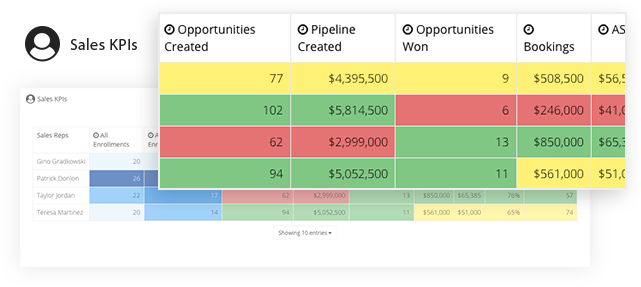5 Areas of hidden waste in the sales revenue production system

This article originally appeared in Forbes.
Imagine you’re running an automobile manufacturing line, and it’s time for quality inspections. For every car deemed acceptable coming off the line, seven are rejected due to defects. That would be an unacceptable amount of waste — and you’ll likely not hold onto that job for long. Indeed, that amount of waste would be unacceptable in any industry. Except for one. Sales.
Unfortunately, at many companies, the revenue production system is clogged with waste — activities leading nowhere. Even worse, these inefficiencies have been accepted by sales organizations as “the way we’ve always done it.” But it’s these hidden defects that often lead to a reduction in revenue production.
By identifying sources of waste and taking steps to plug the holes, sales teams can improve overall results. Here are five areas where hidden waste often lurks:
1. Pipeline-to-quota ratio
That initial car example sounds ridiculous, right? Why would you ask anyone to labor on eight cars, knowing full-well that seven will be rejected?
Unfortunately, that’s exactly what sales leaders do with inflated pipeline-to-quota ratios. A sales pipeline represents every opportunity a rep is handling — and with an eight-fold pipeline, which is not uncommon — that means to produce $1 million in revenue, reps are expected to manage $8 million in opportunity. In other words, it’s assumed they’ll lose seven deals for each deal they win. But why would you want a system where reps are expected to fail almost 90% of the time? Why would you want them to focus, primarily, on deals that won’t close? This is a productivity buster — and bad metrics.
Yet sales leaders often panic, thinking if reps are missing their numbers with, say, a five-fold pipeline, increasing it to eight-times or ten-times will drive improvements. What this really results in, though, is a pipeline clogged with junk.
Keep in mind, a typical rep pipeline includes four types of deals: ones they’ll win, can win, won’t win and, finally, deals that aren’t deals at all — listed for appearance’s sake. Increasing the pipeline multiplier almost always increases the latter two categories — ones that should be eliminated!
Whatever ratio they set, companies should picture their sales pipeline not as a funnel, but as a martini glass: wide at the top but rapidly narrowing. So while you might have a five-time pipeline up top, mechanisms should be in place to reduce it to 2.5-times quickly — so reps don’t waste time on “defective” deals but focus on quality opportunities likely to close.
2. Over-assignment of quota
Let’s say a company has three salespeople assigned to a given territory and a $3 million quota for that territory. It’s common for leaders to assign each rep a $1.25 million quota, as a way to hedge their bets.
But this is a waste of resources. When you over-assign quotas, you’re setting up your reps for failure. Oftentimes, they leave the company, frustrated. Other times reps may simply give up and “coast” partway through the year, demoralized by inflated, unattainable numbers. They may also prolong deals into the next fiscal year, knowing they can’t meet this year’s quota but positioning themselves for the one ahead.

Over-assigning quotas is often a symptom of lack of confidence in sales rep readiness. But if sales reps truly aren’t ready for buyer conversations, instead of asking them to do more, companies should train them better — driving optimal productivity through ongoing education and assessments. Then, they can assign quotas that are realistic and attainable, and reward reps for exceeding them.
3. ‘Sophomore’ sales rep turnover
Data from The Bridge Group shows companies lose about one out of three sales reps every year. Nearly half the turnover is voluntary. In sales, attrition is especially painful when reps leave before they’ve completed their second or third year with a company — that is, before they typically hit their full productivity run-rate — the expected revenue of a fully functional rep.
The math is startling — in addition to losing sales training investments, companies lose the future revenue the departing rep would have produced — which would have increased, incrementally, as the rep neared their full run-rate. Instead, the company has to start over with a new rep, working at a lower run-rate than their predecessor.
To eliminate turnover waste, sales organizations should foster rep retention — providing clearly defined career paths, a sales coaching culture, continuous learning opportunities and avenues for recognition.
Download The Business Case and Playbook for Data-Driven Sales Coaching to learn more about how coaching helps reduce seller attrition.
4. Lack of insight into rep activities
How do your reps spend their time? Very often, that’s a question CSOs can’t answer. They have no idea if reps are squandering productivity on activities that don’t bring much value to buyers or the company.
Performing regular — e.g., biannual — sales activity assessments can shed light. Sales organizations should identify areas where reps spend time on non-selling or non-training activities — such as forecasting/reporting, tracking down contact information or reinventing the wheel on content — and try to minimize that. The goal should be to map the right level of activity to the right level of production, because if you don’t understand the input in a process, you can’t impact the output.
Tools like sales rep scorecards or sales content analytics help provide insight into rep activities by automating tracking and integrating with sales CRMs like Salesforce.

5. Ineffective onboarding
Many companies take wasteful approaches when training new sales reps. For example, let’s look at all-at-once onboarding by firehose. These minutiae-oriented programs — as well as more amorphous ones — result in low retention and force reps to learn in the field. Getting the bugs out with real-world buyers is a very expensive way to onboard!
It’s much more effective to take an agile, assessment-oriented onboarding approach, which emphasizes developing specific skills at agreed-upon times. This approach should be mapped to discrete sales activities a rep must perform — the first prospecting call, the first product demo, etc. Once reps have been certified, they tackle the next skills — again, mapped chronologically to their next key activity.
Onboard your sales reps more effectively by following The Blueprint for Better Sales Onboarding.
Waste removal
Borrowing from principles of lean manufacturing, sales organizations should take a methodical approach — involving sales leadership, sales operations and sales enablement — to identify waste and opportunities for efficiency, while tapping into their reps’ knowledge of what works.
In this way, the revenue production cycle can speed along with minimal defects, just like that nice new car out of the factory!

